#cerastus
Text

The more I fucken looked at the chainsword arm with the pistons the more I hated it. I had left over clock parts from a German clock I tore apart, decided to go with this instead.
Also got rid of the wishy washy metallic/rust colours from the machine parts, doing a black metal (inspired by car exhaust pipe colours), with rust and in the recesses and chrome for the edge highlights
I am sure at some point I’m sure I’ll feel like throwing it in the garbage! Don’t worry about the glossy look on the transfers they’ll flatten out with a nice oil wash.


29 notes
·
View notes
Text







It's beautiful.
#games workshop#citadel miniatures#warhammer 40k#warhammer 30k#horus heresy#age of darkness#questor imperialis#imperial knights#house vyronii#cerastus knight acheron#cerastus knight castigator#warhammer community
89 notes
·
View notes
Text


Cerastus Knight Lancer
97 notes
·
View notes
Text
Week 21: Don't talk to me, or my son, or my son's son ever again.
In the midsts of me painting my army for the games I have scheduled my wife decided she wanted a Cerastus Knight Lancer. Thank god this model is made of plastic now! I would not have wanted to build this if it was still resin. This thing is HUGE for something you can actually run on the tabletop.
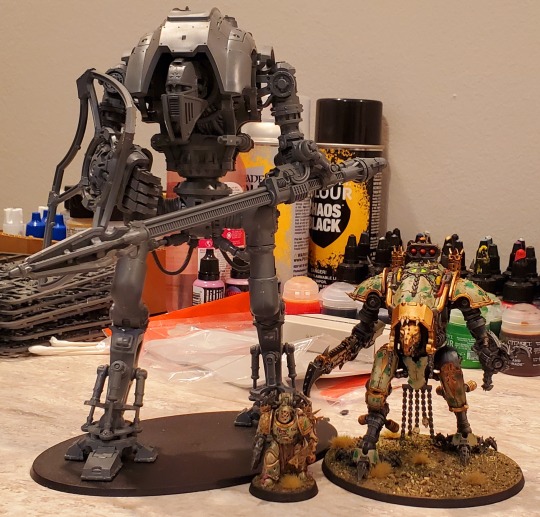
Still figuring out the posing for the arms, but we'll definitely be chaosifying this model to better fit her Emperor's Children army. We're getting ready for the eventual release of Emperor's Children as an army. We've been looking forward to it since I got her into the game. The writing was on the wall back then, but now we just need Games Workshop to commit and release Emperor's Children already. They're getting their own index outside of the CSM Codex. If the models weren't so old we'd consider getting those models, but with them definitely getting a revamp we're super excited. Especially with rumors of updated 40k versions of chaos Phoenix Terminators. I hope they look at least half as good as Deathshroud Terminators if not better. Slaanesh needs all the love in the world when Emperor's Children gets released.
Please James Workshop, gives us good models, especially Fulgrim 🙏
#Warhammer Community#Warhammer#Warhammer 40k#Warhammer Painting#Warhammer 40000#Death Guard#Death Guard 40k#Chaos Knights#War Dog#Cerastus Knight Lancer#Chaos Space Marines#Emperor's Children#Nurgle#Slannesh#CSM#Games Workshop#GW#Miniature
9 notes
·
View notes
Note
I love your young wizards books! There’s an article in the NYTs about “plumes of steam” floating up from the belly of Manhattan and thanks to YW, I know it’s just dragons. ❤️
Thank you!
...And yeah, dragons, absolutely. :) (...Well, these guys, anyway.)
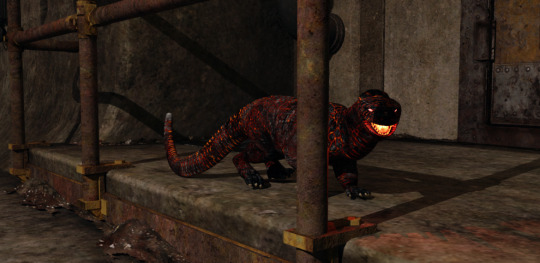
Via the Errantry Concordance: the Fireworm (Lanthanodrax speleotraxis)1
(Also the occasionally occuring “sport” or hypotrophic subspecies, L. speleotraxis ignigastris.) The colloquial name is identical with that used for the marine bristleworm Hermodice carunculata, but the two species otherwise have nothing to do with one another.
The wizardly fireworm is a serious competitor for the title of “North American fauna species that has had its evolution most seriously interfered with by wizardry.”
The original species — just another small reptile, to start with, a member of the suborder Lacertilla and a distant relative of the geckos — was repeatedly mutated by the wizards caught up in the events surrounding the final fate of Afallonë. The most comprehensive change to their structure happened as a side effect of the great aphthonic intervention, the wizardry intended to save as much as possible of the unique Atlantean flora and fauna from the impending destruction of the First Continent. The rafting wizardry which was meant to simply transport a number of species to the newer continents went wrong during the final crisis in many important ways, and rampant wizardry leakage contaminated and disrupted the genetic structures of many of the creatures involved. The fireworm, already susceptible to such disruption because of previous genetic manipulation, suffered far more of it during the transport to the early versions of North America and Europe than any other creature involved in the ancient rafting project.
In Europe and Asia, the fireworm had fewer natural enemies, and grew and changed in ways which would otherwise have been impossible. Further mutations due to the accumulation of wizardly overlays in the more populated parts of Europe led to the rise of the offshoot species Draco, the “true dragons” which became famous in Europe’s medieval period for being killed by knights. (It should be made clear that most of these casualties were members of the species Draco ectenis, the lindworm or wingless dragon, an omnivore by habit and cave-dweller by preference. Even the most heavily armored knights had a terrible batting average against Draco draco europaeis, the cliff-dwelling, strictly carnivorous winged dragon, which regarded knights merely as a somewhat-seasonal comestible delicacy with a crunchy outside and a yummy inside.)
But in North America, where many “rafted” species with wizardly components survived for the next few millennia after the fall of Atlantis, the fireworm kept for some time its original Atlantean form — that of a small carnivorous reptile with a tendency to burp flammable gas as a defense mechanism when frightened or upset. (No carbon-based dragon, true or false, breathes fire: but even the smallest ones can ignite it on exhalation in one of a number of ways, usually involving chemical or enzymatic reactions.)
However, unfortunately for the fireworm, its main Atlantean natural enemy the “king-weasel” (Macrogulo gulo, long extinct and survived only by its far less assertive “family” relative Gulo gulo, the wolverine) succeeded in establishing itself in North America as it had not been able to do in Europe because of the presence of the great crested cockatrice (Cerastus baseliensis) or northern cockatrice (Cerastus scotodasos). The king-weasel nearly succeeded in exterminating the fireworm. Only the smallest members of the family survived by changing their normal above-ground habitats for an underground lifestyle into which the king-weasels would not follow them.
After some millennia spent living and rebuilding their gene pools in the natural caves of the East, the fireworms moved into the manufactured caves and underground spaces of the great East Coast and Midwest cities. (No fireworm species live west of the Rockies. Possibly due to uncomfortable genetic memories secondary to the fall of Afallonë, they will not stay in earthquake-active zones.) Regardless of what ConEd tells you, fireworms are the proximate cause of the steam New Yorkers see coming up from under the streets in all weathers — the more steam, the larger the fireworm.
They are some of the most exothermic of all Earth-based life forms, when well-fed, and the very biggest ones can prosper down in the tunnels in even the coldest weather. When exposed to further wizardry leakage, as sometimes happens in the neighborhood of worldgate complexes, the oldest and most experienced fireworms can over time acquire some telepathic and empathic abilities.2 This enables them to force the smaller fireworms, and even members of some other species, to do their will — shepherding food into their ambit, or otherwise serving their needs. For this reason, smart wizards stay out of places where the older and larger fireworms can be found, unless the needs of errantry drive them there.
Fireworms are also the ultimate source of all the stories about “alligators in the sewers.” There is a certain ironic humor to this, as wizards know there wouldn’t be nearly so many stories if the things in the sewers were only alligators.
(See also: Eldest, the: Twelve, Song of the.) (SYWTBAW)
1The taxonomy of the western European fireworm is somewhat confused. The Bestiarium Ignotum classified the fireworm as Lanthanotrops micrognotus, but this did not take into account the internal differences between the Lanthanotrops and Lanthanodrax families — possibly understandable, since Linnaeus was unable to find a dead specimen to dissect, and trapping a live one was at that point out of the question. The Acta Parabiologica‘s revised classification group places the fireworm among the various members of family Hemerothalcus, with the “true dragons” of the Draco species.
2 Because of the already-fragile state of their DNA, such exposure over prolonged periods can also result in memory loss and other neurological problems, as seems to have been the case with the Eldest in SYWTBAW.
#Young Wizards meta#fireworms#Lanthanodrax speleotraxis#Young Wizards#So You Want To be A Wizard#unnatural history
98 notes
·
View notes
Text

💀💀💀 THE LORD OF SKULLS 💀💀💀

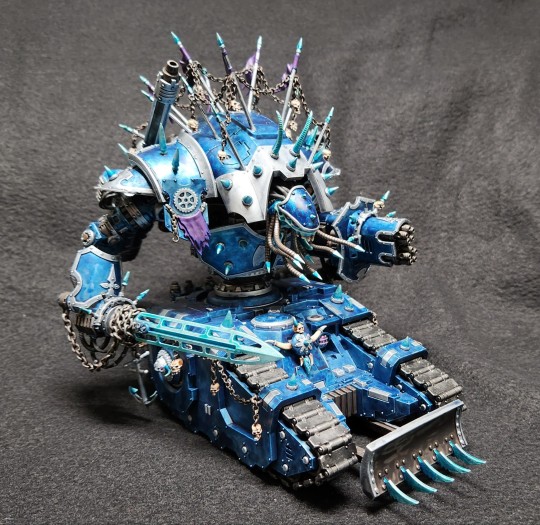
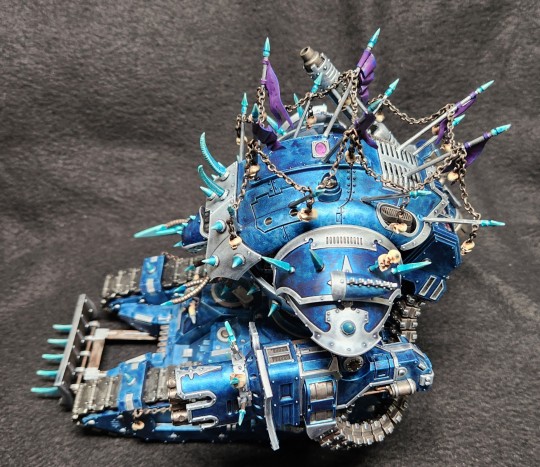

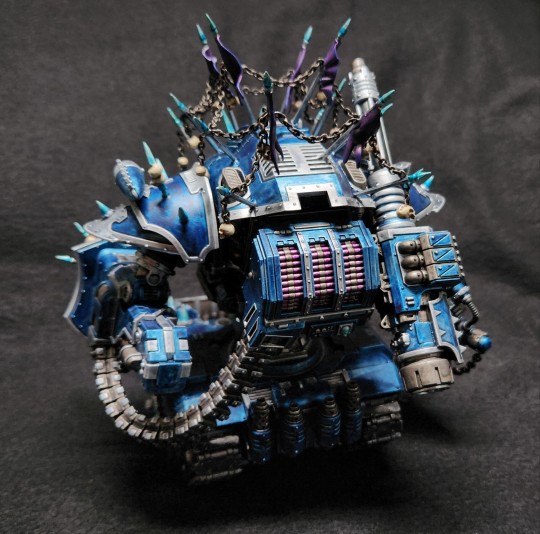
My latest addition to The Dreamers of the Frozen Deep. Because I can never have enough crunchy daemon engines! Model is a mash up of the Cerastus Knight and a Sicaran.
"How does it fight effectively with the tread body," you ask?? Look man, I'm not playing Chaos because I want to get hung up on details of practicality.
#May have been playing a little too much AC6 when I thought of this kitbash#my stuff#miniature painting#warhammer 40k#chaos space marines#lord of skulls
60 notes
·
View notes
Text
I don't think enough people know that, despite their massive size and generally more threatening appearance, cerastus class knights are basically Mad Max vehicles.
Most knight classes(dominus, questoris, armiger, etc.) were originally utility vehicles during the Long March colonization effort during the Dark Age of Technology. They were made, ultimately, to give humanity an upper hand and help them out as they wandered the stars, equal parts war engine and construction vehicle.
The cerastus chassis is another story. They trace their origins to the Age of Strife, after the ai rebellion nearly shattered humanity. Cerastus class knights are built for war and war alone, the tools used by despots of old to tear down opposing knight houses and crush rebellions, feral machine spirits slavering at the merest notion of violence. A symbol of a darker time I'm every respect.
That is the primary lore reason you don't see these guys all over in 40k. Only a few remained in each house by the time of the Great Crusade, so when the Horus Heresy broke out it took out most of the remaining suits.
So this guy?
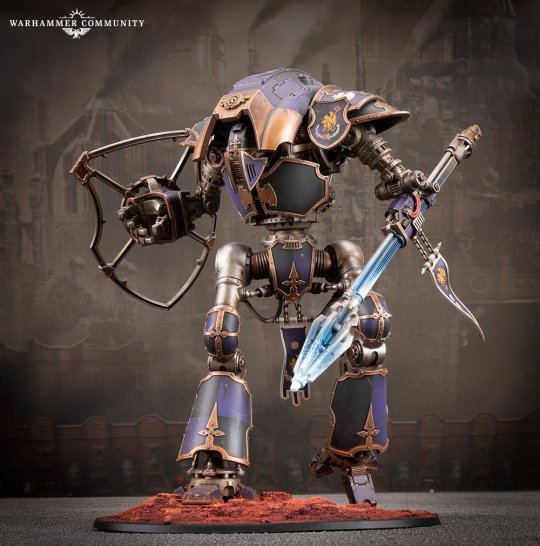
He might look like a paragon of chivalry, but to other knights he's a sign of the times. Everything has gone back to shit so they're hauling out ancient monsters from ages past.
14 notes
·
View notes
Text
Let's Go LGBTs!

Mechanicum Battlegroup coming to preorder this Saturday.
Knight Battle Group, Castigator and Acheron, a double Cerastus Knight box, is also coming.
....
Devestation of Tallarn Legions Imperialis book and a bunch of the "Epic Scale" Tanks also coming.
....
Dwarf Made to Order stuff for TOW.
.....
Speaking of Dwarves, White Dwarf 503 has a heavy Leagues of Votann focus (might get).
.....
A "Divine" model reveal coming tomrrow, as well as a mechanicum focus on Warcom, among the usual.
#adeptus mechanicus#admech#cult mechanicus#the horus heresy#leagues of votann#40k#imperial knights#warhammer#mechanicum#darkmech#warp mechanicum#dark mechanicum
11 notes
·
View notes
Text
me: i should really get one of those cerastus knights since they're in plastic now. i mean, i do so love painting imperial knight, it will be quite fun!
remembers that they're $350 aud
also remembers that u only get one variant per kit rather than a kit that builds all the variants like the questoris knight and dominus knight kits
me: u kno what maybe i dont want one that badly
#its kinda bullshit honestly#at least put all the bits in one kit#like give me all those spare parts to play around with u assholes#40k#warhammer 40k#my stuff
4 notes
·
View notes
Text
My Cerastus Knight Lancer. Him a chaotic boi added to my house Corvax army.
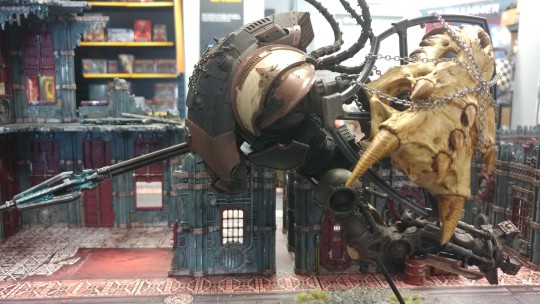
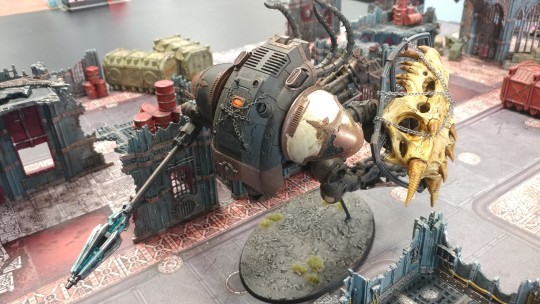

#warhammer#warhammer 40k#warhammer 40000#miniature#armor#chaos#knight#corvax#house#gold#black#rust#kitbash#kit#bash#superman#punch
14 notes
·
View notes
Text





Night Lords, Cerastus Knight Acheron. Deveton. Wip
I’m going to make him super grimy and change the shoulder guards to a darker colour….


18 notes
·
View notes
Text



Going from resin to plastic is already a huge value add, but it's nice to see that the Cerastus kit will be adding a bunch of features and conveniences that they original Forge World kit lacked.
#games workshop#citadel miniatures#warhammer 40k#warhammer 30k#horus heresy#age of darkness#questor imperialis#imperial knights#cerastus knight lancer#warhammer community
117 notes
·
View notes
Text
Homebrew Lore Dump:
Fall of Cadia causes Tecolote System to be eaten by the warp for 150 Years. They stuck in the warp for 150 year, but only 3 years pass in the Materium.
999.M41 Entire Tecolote System Consumed by Cicatrix Maledictim and contained in Realspace Bubble
System subjected to constant and repeated invasions of their Realspace Bubble by Space Hulks and Pirate fleets consisting mainly of either Ork Freebooter Waaaghs, Chaos Space Marine Warbands, Dark Eldar Corsairs, and Genestealers.
Homegrown Feral Ork Waaaghs happen occasionally as well.
001-003.M42
2 years into Isolation Planetary Civil War starts.
Loyalist Elysians & Kanaks vs Renegade Penals. Hive Aquilla & Rual Villages held by loyalists, Hives Alamode, Tehas, Caulifaña, & NeuYurt held by Renegades.
Genestealers Uncovered and revealed to be instigators.
Centurian Rangers Established to combat and eliminate Genestealer Kelermorphs
Centurian Rangers formed by combining elite Guard Veterans & Arbites, with Scola Progenia Commisariat Staff & Scion Cadets.
Squat neutrality ends. Squats enter war on side of loyalists against Genestealers & Renegades.
Majority of Renegades turn on Genestealers. Some Renegade forces occasionally engage in temporary ceasefire with Loyalists to combat Genestealers.
Upon eradication of Genestealer menace, peace negotiations with Renegades are initiated.
Renegades granted amnesty and full citizenship in exchange for cessation of hostilities and submission to Loyalist authorities
Civil War is ended after 10 years of fighting
Surviving Loyalist Authorities enact several governmental reforms
Penals given full rights. Planetary government reformed onto Federation of Hives and Strongholds named United Settlements of Aquilla
Planetary Governor Becomes Elected Position.
New Planetary Governor commissions Lockstock's Rust Blood Reivers to supplement PDF Naval Forces in Anti-Piracy Operations
Roughly 20 years into Tecolote System's warp Isolation, Joint Squat/Imperial mining Colonies established on Dwarf Planet Tecolote IV. Squats provide skilled labor, Imperials provide Penal Chain gangs as mass unskilled labor.
Roughly 80 years into Tecolote System's warp Isolation, a small Transport Fleet bearing a Lace of Freeblade Imperial Knights enters System. Fleet beset by Ork Freebooters. Rust Blood Reivers render aid and eliminate Freebooters. Freeblade Knight Señor Hidalgo Don Coyóte offers the services of his Cerastus Knight Lancer "El Rocinante" and his Freeblade Lance of Armigers known as "Los Becerrillos"
Señor Don Coyóte given fiefdom over Dwarf Planet and Mining Colonies.
Señor Don Coyóte marries Ørnverden Planetary Governor's daughter and Establishes House La Mancha. Also names Dwarf Planet and all mining Colonies "La Mancha
"Los Tercios de Mastìn" Established by House La Mancha as Personal Guard and PDF Regiment for Dwarf Planet.
16 notes
·
View notes
Text










Legio Astorum: 2 Warlords, 2 Warhounds, 3 Cerastus Lancers
Legio Fureans: 1 Warlord, 2 Reavers, 3 Warhounds
My mission was to kill his Warlord ASAP, his was to maximize damage to my force.
It was a very close, carnage-filled game. Quite a few hilarious sequences, but the Lancers VS Warlord saga was the funniest.
Turn 1: I flubbed Full Stride.
Turn 2: I Full Strode, hiding in a smokescreen that blocked his WL's line of sight, perfectly 12" away from the target.
Turn 3: I flubbed the Charge order, sadly moving them over normally and then rolling garbage on my attacks. 2/3 then killed by his Warhound.
Turn 4: I land a Charge, running my last Lancer behind him and stabbing him brutally, within an inch of his life. Massive reactor leak, Void Shields down. He moves away and his Warhound kills the last Lancer. Reactor deep in the danger zone.
Turn 5: I put my surviving Warlord on First Fire to blast him ASAP, fail to kill him, he laughs, and then flubs his Reactor damage roll, Chernobyls and dies.
Survivors were my second Warlord (the one not on fire) and one Reaver and Warhound on his end. Totally wild game, and we were laughing the whole time - Titanicus at its best.
It is too carnage-y for the fluff to be quite right. With all the emphasis about the God Machines being massive, hugely armored monstrosities, a game ending with 7/10 dead feels off. The club tried a campaign years back, before I started, and the attrition was just unsustainable because of how high casualties were every game. The titans play like I'd expect an Ork Gargant faction to play in a generalized Warhammer titan combat game
3 notes
·
View notes
Photo
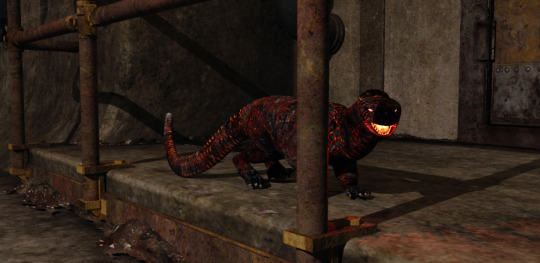
From So You Want To Be A Wizard: the Fireworm (Lanthanodrax speleotraxis).1
(Also the occasionally occuring “sport” or hypotrophic subspecies, L. speleotraxis ignigastris.) The colloquial name is identical with that used for the marine bristleworm Hermodice carunculata, but the two species otherwise have nothing to do with one another.
The wizardly fireworm is a serious competitor for the title of “North American fauna species that has had its evolution most seriously interfered with by wizardry.”
The original species — just another small reptile, to start with, a member of the suborder Lacertilla and a distant relative of the geckos — was repeatedly mutated by the wizards caught up in the events surrounding the final fate of Afallonë. The most comprehensive change to their structure happened as a side effect of the great aphthonic intervention, the wizardry intended to save as much as possible of the unique Atlantean flora and fauna from the impending destruction of the First Continent. The rafting wizardry which was meant to simply transport a number of species to the newer continents went wrong during the final crisis in many important ways, and rampant wizardry leakage contaminated and disrupted the genetic structures of many of the creatures involved. The fireworm, already susceptible to such disruption because of previous genetic manipulation, suffered far more of it during the transport to the early versions of North America and Europe than any other creature involved in the ancient rafting project.
In Europe and Asia, the fireworm had fewer natural enemies, and grew and changed in ways which would otherwise have been impossible. Further mutations due to the accumulation of wizardly overlays in the more populated parts of Europe led to the rise of the offshoot species Draco, the “true dragons” which became famous in Europe’s medieval period for being killed by knights. (It should be made clear that most of these casualties were members of the species Draco ectenis, the “lindworm” or wingless dragon, an omnivore by habit and cave-dweller by preference. Even the most heavily armored knights had a terrible batting average against Draco draco Europaeis, the cliff-dwelling, strictly carnivorous winged dragon, which regarded knights merely as something with a crunchy outside and a yummy inside.)
But in North America, where many “rafted” species with wizardly components survived for the next few millenia after the fall of Atlantis, the fireworm kept for some time its original Atlantean form — that of a small carnivorous reptile with a tendency to burp flammable gas as a defense mechanism when frightened or upset. (No dragon, true or false, breathes fire: but even the smallest ones can ignite it on exhalation in one of a number of ways, usually involving chemical or enzymatic reactions.) However, unfortunately for the fireworm, its main Atlantean natural enemy the “king-weasel” (Macrogulo gulo, long extinct and survived only by its far less assertive “family” relative Gulo gulo, the wolverine) succeeded in establishing itself in North America as it had not been able to do in Europe because of the presence of the great crested cockatrice (Cerastus baseliensis) or northern cockatrice (Cerastus scotodasos). The king-weasel nearly succeeded in exterminating the fireworm: only the smallest members of the family survived by changing their normal above-ground habit for an underground lifestyle into which the king weasels would not follow them.
After some millennia spent living and rebuilding their gene pools in the natural caves of the East, the fireworms moved into the manufactured caves and underground spaces of the great East Coast and Midwest cities. (No fireworm species live west of the Rockies: possibly due to uncomfortable memories secondary to the fall of Afallonë, they will not stay in earthquake-active zones.) Regardless of what ConEd tells you, fireworms are the proximate cause of the steam New Yorkers see coming up from under the streets in all weathers — the more steam, the larger the fireworm. They are some of the most exothermic of all Earth-based life forms, when well-fed, and the very biggest ones can prosper down in the tunnels in even the coldest weather. When exposed to further wizardry leakage, as sometimes happens in the neighborhood of worldgate complexes, the oldest and most experienced fireworms can over time acquire some telepathic and empathic abilities.2 This enables them to force the smaller fireworms, and even members of some other species, to do their will — shepherding food into their ambit, or otherwise serving their needs. For this reason, smart wizards stay out of places where the older and larger fireworms can be found, unless the needs of errantry drive them there.
Fireworms are also the ultimate source of all the stories about “alligators in the sewers.” There is a certain ironic humor to this, as wizards know there wouldn’t be nearly so many stories if the things in the sewers were only alligators.
(See also: Eldest, the: Twelve, Song of the.) (SYWTBAW)
1The taxonomy of the western European fireworm is somewhat confused. The Bestiarium Ignotum classified the fireworm as Lanthanotrops micrognotus, but this did not take into account the internal differences between the Lanthanotrops and Lanthanodrax families — possibly understandable, since Linnaeus was unable to find a dead specimen to dissect, and trapping a live one was at that point out of the question. The Acta Parabiologica‘s revised classification group places the fireworm among the various members of family Hemerothalcus, with the “true dragons” of the Draco species.
2 Because of the already-fragile state of their DNA, such exposure over prolonged periods can also result in memory loss and other neurological problems, as seems to have been the case with the Eldest in SYWTBAW.
104 notes
·
View notes
Text

2000 points of my Legio Lucidium titans about to play at an event. Minimum demi Arcus, and demi Corsair, supported by a pair of Cerastus Lancers.
9 notes
·
View notes